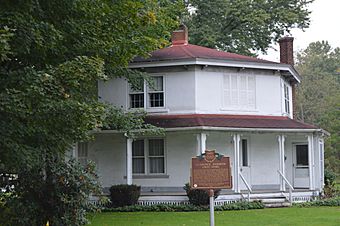Clarence Darrow Octagon House facts for kids
Quick facts for kids |
|
|
Clarence Darrow Octagon House
|
|

Roadside view of the house
|
|
| Location | State Routes 5 and 7, Kinsman, Ohio |
|---|---|
| Area | Less than 1 acre (0.40 ha) |
| Built | 1854 |
| Architectural style | Octagon Mode |
| NRHP reference No. | 71001025 |
| Added to NRHP | September 10, 1971 |
The Clarence Darrow Octagon House is a special historic home in Kinsman, Ohio, United States. It's called an octagon house because it has eight sides. This house was once the childhood home of a very famous lawyer named Clarence Darrow. Today, it is recognized as an important historic site.
Contents
Who Was Clarence Darrow?
Clarence Darrow was born near Kinsman, Ohio. His father was a cabinetmaker. When Clarence was seven years old, in 1864, his family moved into this octagon house. He lived there until about 1873.
Clarence Darrow grew up to be a nationally known lawyer. He remembered the octagon house as a very important place. It was here that he first became interested in law. He even played "mock trials" with his friends! Darrow visited the house one last time in 1936, two years before he passed away.
What is an Octagon House?
The Darrow House was built around 1854. It's a great example of an octagon house. These homes were popular for a short time in the mid-1800s. A man named Orson Squire Fowler believed they were better homes for people. He thought the eight-sided design made the inside space more useful.
The House's Special Design
This house is mostly made of wood. Its walls are made from chestnut wood. Concrete was used to fill in the gaps between the logs. Inside, the house has seven rooms. Many of the original wooden parts are still there. This includes cupboards, fireplaces, and their decorative mantels.
A large porch goes around the first floor of the house. It's on seven of the eight sides. Each side has windows in the middle on both floors. A chimney sticks out from the very center of the roof.
A Historic Landmark
In September 1971, the Clarence Darrow Octagon House was added to the National Register of Historic Places. This is a list of important places in the United States. It was listed just one week after two other Kinsman buildings. These were the Congregational-Presbyterian Church and the Dr. Peter Allen House.
There are seven octagon houses in Ohio on this special list. Most were built around 1860. However, "the Octagon" in Tiffin, Ohio is even older, from 1852. The Darrow House is unique among them. It was added to the list mainly because of Clarence Darrow. Other octagon houses were listed because of their special architecture. In 2000, a state historical marker was placed in front of the house.



